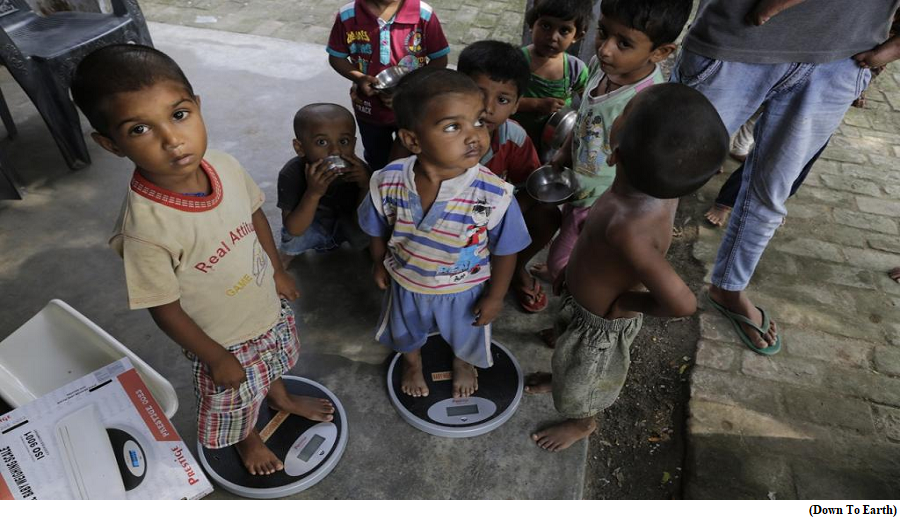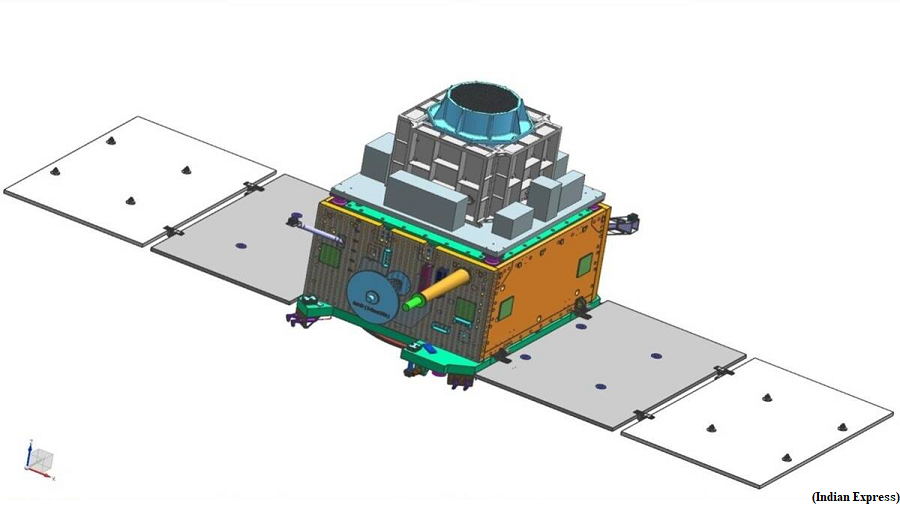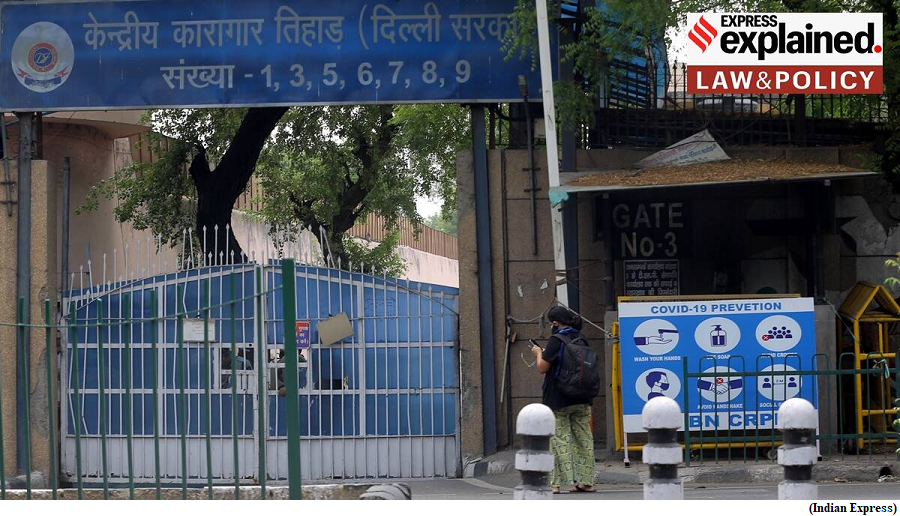India child wasting rate 18.7 percent as per latest UN inter agency estimates (GS Paper 1, Social Issues)

Why in news?
- Recently, a report titled, ‘Levels and trends in child malnutrition: Joint Child Malnutrition Estimates (JME)’ was launched by UNICEF / WHO / World Bank Group.
Child wasting:
- In 2020, some 18.7 per cent of Indian children were affected by wasting caused by poor nutrient intake and / or recurrent illnesses.
- India is the largest country in southern Asia, which is where half of all children with wasting in the world live. In 2022, an estimated 45 million children under five (6.8 per cent) were affected by wasting globally, of which 13.6 million (2.1 per cent) were suffering from severe wasting.
- More than three quarters of all children with severe wasting live in Asia and another 22 per cent live in Africa.
- Children suffering from wasting have weakened immunity, and are susceptible to long-term developmental delays and face an increased risk of death, particularly when wasting is severe.
Child stunting:
- India had a stunting rate of 31.7 per cent in 2022, down from 41.6 per cent in 2012, a decade ago.
- Some 148.1 million, or 22.3 per cent of children under age five worldwide, were affected by stunting in 2022.
- Nearly all children affected lived in Asia (52 per cent of the global share) and Africa (43 per cent of the global share).
- Stunting is the devastating result of poor nutrition in-utero and during early childhood. Children suffering from stunting may never attain their full possible height and their brains may never develop to their full cognitive potential.
Overweight:
- Meanwhile, there are now 37 million children under five who are overweight globally, an increase of nearly four million since 2000, according to the document.
- Childhood overweight occurs when children’s calorie intake from food and beverages exceeds their energy requirements.
- This form of malnutrition is driven by failing food systems characterised by poor affordability as well as access to nutritious foods, the marketing of nutrient-poor ultra-processed foods, as well as inadequate opportunities for physical activity.
- India had an overweight percentage of 2.8 per cent in 2022, compared to 2.2 per cent in 2012.
Progress in achieving SDG Goal:
- JME released in 2023 reveal insufficient progress to reach the 2025 World Health Assembly (WHA) global nutrition targets and UN-mandated Sustainable Development Goal target 2.2.
- Only about a third of all countries are ‘on track’ to halve the number of children affected by stunting by 2030 and assessment of progress to date not being possible for about one quarter of countries.
- Even fewer countries are expected to achieve the 2030 target of 3 per cent prevalence for overweight, with just one in six countries currently ‘on track’. An assessment of progress towards the wasting target is not possible for nearly half of countries, according to the report.
XPoSat, India’s first polarimetry mission
(GS Paper 3, Science and Technology)
Why in news?
- The Indian Space Research Organisation is collaborating with the Raman Research Institute (RRI), Bengaluru, to build the X-Ray Polarimeter Satellite (XPoSat) that is scheduled to be launched in 2023.
- Recently, ISRO Chairman urged Indian scientific institutions to identify talented students and take steps to motivate them in effectively using the data emerging from science-based space missions.

What is the XPoSat mission?
- XPoSat will study various dynamics of bright astronomical X-ray sources in extreme conditions.
- It has been billed as India’s first, and only the world’s second polarimetry mission that is meant to study various dynamics of bright astronomical X-ray sources in extreme conditions.
IXPE:
- The other such major mission is NASA’s Imaging X-ray Polarimetry Explorer (IXPE) that was launched in 2021.
- IXPE carries three state-of-the-art space telescopes. Each of the three identical telescopes hosts one light-weight X-ray mirror and one detector unit. These will help observe polarized X-rays from neutron stars and supermassive black holes.
- By measuring the polarisation of these X-rays, helps study where the light came from and understand the geometry and inner workings of the light source.
How are X-Rays witnessed in space?
- X-rays have much higher energy and much shorter wavelengths, between 0.03 and 3 nanometers, so small that some x-rays are no bigger than a single atom of many elements.
- The physical temperature of an object determines the wavelength of the radiation it emits. The hotter the object, the shorter the wavelength of peak emission.
- X-rays come from objects that are millions of degrees Celsius — such as pulsars, galactic supernova remnants, and black holes.
- The fishermen use polarised lenses to reduce glare from sunlight when they are near water.
- The field of polarimetry studies the measurement of the angle of rotation of the plane of polarised light (that is, a beam of light in which the vibrations of the electromagnetic waves are confined to one plane) that results upon its passage through certain transparent materials.
Significance:
- The emission mechanism from various astronomical sources such as black holes, neutron stars, active galactic nuclei, pulsar wind nebulae etc. originates from complex physical processes and are challenging to understand.
- Space based observatories are also unable to give information about the exact nature of the emission from such sources. Therefore, newer devices can measure specific properties.
What are XPoSat’s payloads?
- The spacecraft will carry two scientific payloads in a low earth orbit.
- The primary payload POLIX (Polarimeter Instrument in X-rays) will measure the polarimetry parameters (degree and angle of polarisation).
- The payload is being developed by RRI in collaboration with ISRO’s U R Rao Satellite Centre (URSC) in Bengaluru.
- POLIX is expected to observe about 40 bright astronomical sources of different categories during the planned lifetime of XPoSat mission of about 5 years. This is the first payload in the medium X-ray energy band dedicated for polarimetry measurements.
- The XSPECT (X-ray Spectroscopy and Timing) payload will give spectroscopic information (on how light is absorbed and emitted by objects). It would observe several types of sources, such as X-ray pulsars, blackhole binaries, low-magnetic field neutron star, etc.
Model Prisons Act announced by the MHA
(GS Paper 2, Governance)
Why in news?
- The Ministry of Home Affairs (MHA) has finalised the preparation of the Model Prisons Act, 2023, to replace the existing 130-year-old colonial law in an attempt to shift the focus of incarceration from “retributive deterrence” to “reform and rehabilitation”.
- The 2023 Act seeks to bring in the use of technology in prison management, make provisions for the grant of parole, furlough, and remission, and introduce special provisions for women and transgender inmates.

What is the backdrop against which the 2023 Act is being introduced?
- The Model Prisons Act, 2023, is being introduced following the spate of killings and gang violence within prisons.
- The pre-Independence Prisons Act, 1894, focused on keeping criminals in custody and enforcing discipline and order in prisons, leaving “no provision for reform and rehabilitation of prisoners”.
- Owing to new perspectives evolving on prisons and prison inmates, globally” in the last few decades, the Ministry reasoned that prisons are not seen as “places of retributive deterrence” today but instead as “reformative and correctional institutions” where prisoners transform and rehabilitate back into society as law-abiding citizens.
- Thus, the MHA assigned the task of revising the Prisons Act, 1894, to the Bureau of Police Research and Development. The bureau, after holding wide-ranging discussions with state prison authorities and correctional experts, among others, prepared the draft, which culminated in the 2023 Act.
What are the new provisions being proposed?
- In an attempt to overhaul the colonial 1894 Act, the Model Prisons Act seeks to create provisions for the grant of parole, furlough, and remission to prisoners to encourage good conduct.
- Additionally, it aims to provide separate accommodation for women and transgender inmates, ensure the physical and mental well-being of prisoners, and focus on the reformation and rehabilitation of inmates.
- The new Act also intends to bring about “attitudinal change towards prisoners” and initiate vocational training and skill development for prisoners for their reintegration into society.
- The 2023 Act also seeks to bring about “transparency in prison management” and includes provisions for security assessment and segregation of prisoners; individual sentence planning; grievance-redressal; prison development board; use of technology in prison administration; and protecting society from criminal activities of hardened criminals and habitual offenders. Provisions for establishing high-security jails and open, semi-open jails have also been inserted.
- Apart from this, new measures for prisoners to video conference with courts have also been introduced. However, if a prisoner is using prohibited items like mobile phones in jail, they will be punished for it.
- Along with the Prisons Act, 1894, the Prisoners Act, 1900, and the Transfer of Prisoners Act, 1950’ have also been reviewed by the MHA, and their relevant provisions have been assimilated into the Model Prisons Act, 2023.
Is the Model Prisons Act, 2023, binding on states?
- As per the provisions of the Constitution, ‘prisons’ and ‘persons detained therein’ fall under the State List. This means that the responsibility of prison management and administration solely vests with the state government, which alone is competent to make appropriate legislative provisions in this regard.
- However, the MHA stated that owing to the critical role played by “efficient prison management” in the criminal justice system, the Centre finds it crucial to support the States and UTs in this regard.
- Moreover, since there were “several lacunae in the existing Prisons Act, which regulates the prison administration” in most states and UTs, the government thought it fit to revise the law to align it with “modern day needs and requirements of prison management”.
- The ministry also clarified while announcing the 2023 Act that it “may serve as a guiding document for the States” so that they may benefit from its adoption in their jurisdictions.




